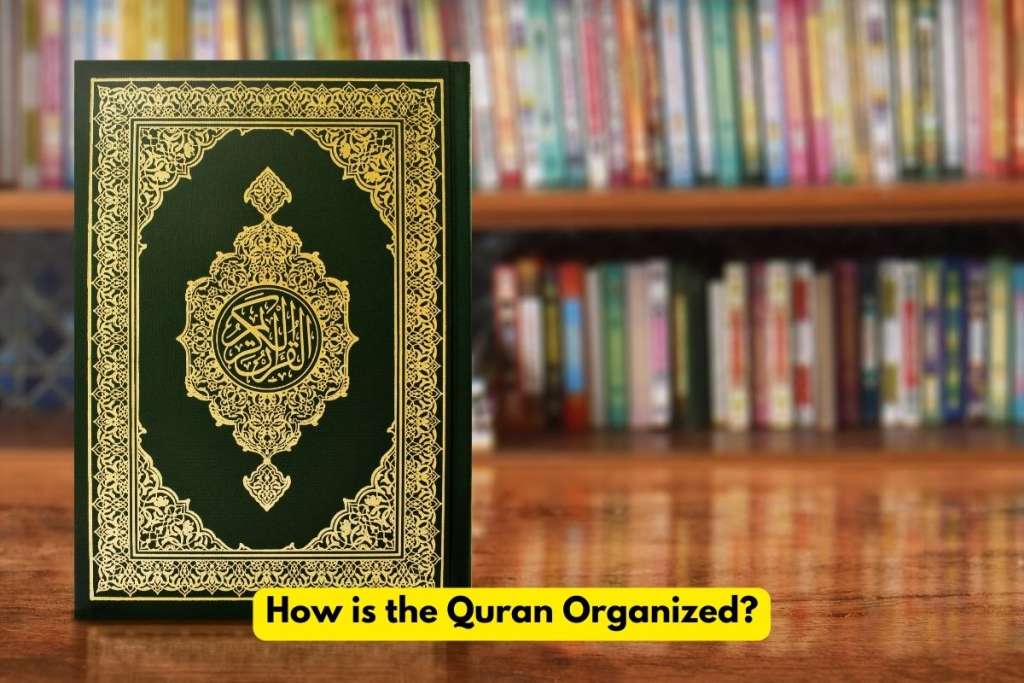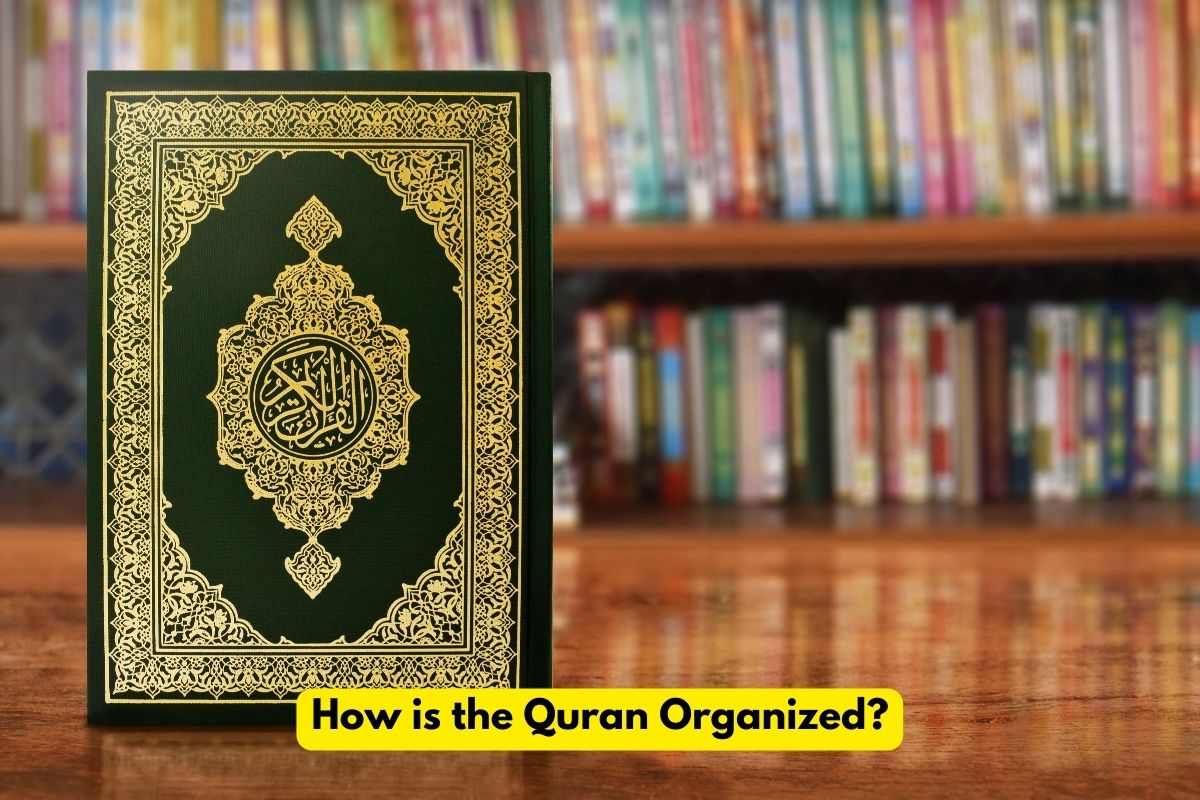The Quran is not just a collection of verses. The surahs are arranged carefully and offer a glimpse into the divine origins. The Quran’s organization is strategic and purposeful.
This article explores the Quran’s structure and the impact the Quran has on Muslims. From the opening verses to the closing surahs.
So, how is the Quran organized? The Quran is organized into 114 chapters, known as surahs, which are arranged in descending order of length. This structure places longer surahs at the beginning and shorter ones toward the end. aiding memorization and recitation.
If you want to know more about the fascinating origin story of how is the quran organized and put together, how the order was determined, and what’s the original language of the Quran, all you have to do is keep reading.
How Is The Quran Organized?

The Quran is organized into chapters called “surahs” and verses called “ayat.” The Quran is divided into 114 surahs of varying lengths, and each surah is further divided into ayat.
The arrangement of surahs in the Quran is not chronological; rather, it is organized based on the length of the surahs, with the longest ones generally placed at the beginning and the shorter ones towards the end.
The surahs are often named based on a keyword mentioned within them. The Quran was revealed to the Prophet Muhammad (peace be upon him) over a period of approximately 23 years, and the different revelations were recorded and compiled into the holy Quran we have today.
The Quran covers a wide range of topics, including theology, guidance for personal conduct, legal principles, stories of previous prophets, and discussions on various aspects of life.
Some surahs were revealed in Mecca, while others were revealed in Medina, and this distinction is significant as it impacts the context and content of the verses.
The arrangement of the surahs and the content within them is considered by Muslims to be divinely ordained and holds deep spiritual and practical significance within the Islamic faith, that’s why it’s so important to understand this to learn the concepts of how is the quran organized.
How Are The Chapters Of The Quran Arranged?
Here’s a general overview of how the chapters of the Quran are arranged to gain a good understanding of how is the Quran organized;
- Shortest Chapters: The shorter surahs are placed towards the end of the Quran. These surahs are often referred to as the “Makki” surahs, as many of them were revealed during the Prophet Muhammad’s time in Mecca. Examples include Surah Al-Kawthar (Chapter 108) and Surah Al-Ikhlas (Chapter 112).
- Longer Chapters: The longer surahs are found towards the beginning of the Quran. These surahs include both “Makki” surahs (revealed in Mecca) and “Madani” surahs (revealed in Medina). Examples include Surah Al-Baqarah (Chapter 2) and Surah Al-‘Imran (Chapter 3).
- Opening Chapter: The first chapter of the Quran is Surah Al-Fatiha (Chapter 1), which serves as an opening prayer and is recited in every unit of the Islamic prayer (Salat).
- Centerpiece: The surah at the center of the Quran is Surah Al-Kahf (Chapter 18), which holds special significance and is often read on Fridays by many Muslims.
- Topics: The arrangement of the surahs also groups together chapters with similar topics. For example, many of the early Makki surahs deal with matters of faith, the Oneness of God, and the stories of past prophets. Later Madani surahs often address legal and practical matters for the growing Muslim community.
It’s important to note that while the order of the surahs is consistent across various versions of the Quran, the division into verses (ayat) was done later for ease of reading and referencing.
Who Wrote The Quran?
The Quran was revealed to the Prophet Muhammad (peace be upon him) through the angel Gabriel (Jibril in Arabic).
The process of revelation took place over a period of approximately 23 years, during which the Prophet Muhammad received guidance, teachings, and instructions from Allah.
The Quran was transmitted orally by the Prophet Muhammad to his companions, who memorized and recorded it.
The companions, known as the Sahabah, preserved the Quranic revelations both in their memories and in written form.
After the Prophet Muhammad’s passing, the Quranic revelations were collected and compiled into a single book during the caliphate of the third caliph, Uthman ibn Affan.
Gain a much deeper understanding of the Quran with our Quran Online Courses for Muslims of all levels and around the world today. Reserve your spot here today!
How Was The Quran Put Together?
The compilation of the Quran was a meticulous and careful process. It was undertaken during the caliphate of the third caliph, Uthman ibn Affan (may Allah be pleased with him).
The process involved collecting the various written and oral versions of the Quranic revelations and producing a standardized written text. Here’s a general overview of how the Quran was put together:
- During the Prophet’s Lifetime: Throughout the Prophet Muhammad’s (PBUH) prophethood, the Quranic revelations were received in segments over a period of about 23 years.
- These revelations were preserved both in the memories of the Prophet and his companions (Sahabah). They were preserved in written form on various materials such as parchment, and palm leaves.
- Compilation Under Abu Bakr: After the passing of the Prophet Muhammad, Abu Bakr (may Allah be pleased with him), the first caliph, recognized the importance of compiling the Quran to ensure its preservation.
Zayd Ibn Thabit:
- He assigned Zayd ibn Thabit, a scribe who had been close to the Prophet, to collect the scattered written portions of the Quran.
- Zayd and his team gathered the Quranic verses from various sources and compiled them into a single manuscript.
- Final Compilation Under Uthman: During the caliphate of Uthman ibn Affan, around 20 years after the passing of the Prophet Muhammad, the Muslim community had spread far and wide, and variations in the way the Quran was recited had emerged due to dialectal differences.
Uthman recognized the need to establish a standard version of the Quran to maintain its authenticity and unity.
Uthman ordered the preparation of multiple copies of the compiled Quranic text that Abu Bakr and Zayd had put together.
These copies were written in the Quraishi dialect, the dialect of the Prophet Muhammad. Uthman sent these copies to different regions of the Islamic empire, along with expert reciters, to ensure the correct pronunciation and recitation of the Quranic verses.
Standardization and Preservation: Uthman’s compilation efforts resulted in a standardized written text of the Quran that was consistent across the Muslim world.
The copies he distributed were considered authoritative, and any variations that existed were reconciled according to the standardized text.
Gain a much deeper understanding of the Quran with our Quran Online Courses for Muslims of all levels and around the world today. Reserve your spot here today!
How Was The Order Of The Quran Determined?
The arrangement of the surahs was established during the time of the third caliph, Uthman ibn Affan, and it is considered part of the Quran’s preservation.
While the exact reasoning behind the order chosen by Uthman is not explicitly documented in historical sources, scholars and historians have suggested a few possible reasons for the arrangement:
Length and Complexity: The arrangement of surahs follows a general pattern of length, with longer surahs positioned at the start and shorter ones towards the end.
Spiritual and Rhetorical Considerations: Some scholars propose that the arrangement might also have spiritual and rhetorical significance, guiding the reader through a journey of faith and understanding.
The Quranic text is known for its intricate and profound use of language and rhetoric, and the arrangement could contribute to the overall impact of the message.
Instructional Progression: The order might have been designed to facilitate a gradual understanding of Islamic teachings, with fundamental concepts introduced early on and more intricate matters elaborated upon later.
It’s important to note that while scholars have offered insights into the potential reasons behind the arrangement, the exact intentions of Uthman and the early Muslim community are not definitively documented.
What Is The Original Language Of The Quran?
The original language of the Quran is Classical Arabic. The Quranic text is highly regarded for its linguistic beauty, eloquence, and depth of meaning.
It has had a significant impact on the Arabic language itself and has served as a foundational text for Arabic literature, grammar, and rhetoric.
Because of the divine origin and the importance of Islamic worship, the Quran is traditionally recited, memorized, and studied by Muslims around the world in its original language, even if they do not speak Arabic as their first language.
Translations of the Quran exist in many languages to facilitate understanding for non-Arabic speakers, but the original Arabic text is considered unique and untranslatable due to the intricacies of its language and the depth of its meaning.
If you liked this article, you can check out our other articles and if you found it useful you can share it with your family and friends it may be helpful to them as well, and if you have any questions, please do not hesitate to contact us.
Gain a much deeper understanding of the Quran with our Quran Online Courses for Muslims of all levels and around the world today. Reserve your spot here today!
Related Questions
Which Prophet is mentioned the most in the Quran?
The Prophet Moses (Musa in Arabic) is mentioned the most frequently among all the prophets in the Quran. His story and teachings are recounted in various surahs, The Quran narrates aspects of his life, and encounters with Pharaoh, providing valuable lessons and insights for believers.
Who is the only woman named in the Quran?
The only woman explicitly named in the Quran is Maryam, the mother of Isa AS. Her story and her miraculous birth are mentioned in several places within the Quran, including Surah Maryam (Chapter 19). Maryam holds a special place as a symbol of virtue and faith.
If you found this article helpful, please share it. If you have any questions or comments, please drop us a comment below and we’ll be more than ready to help you.






